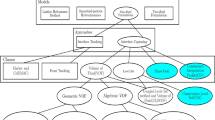Summary
The finite element method is used for the analysis of the behavior of a nonspherical bubble in a viscous incompressible liquid under axial conditions. The finite element approximations of the Navier Stokes equations are formulated by taking velocity and pressure as unknown variables. The flow field is discretized by triangular elements, and the bubble surface is represented by isoparametric elements with curved sides. This numerical technique is applied to the simulation of an initially spherical vapor bubble collapsing near a plane solid wall. It is made clear that a jet formed on the bubble is decelerated by the effect of liquid viscosity.
Übersicht
Mit dem Verfahren der Finiten Elemente wird das Verhalten einer nichtkugelförmigen Blase in einer zähen inkompressiblen Flüssigkeit bei rotationssymmetrischen Bedingungen untersucht. Die Navier-Stokesschen Gleichungen werden mit der Methode der Finiten Elemente näherungsweise gelöst. Das Strömungsfeld um die Blase wird in kleine dreieckige Elemente zerlegt, wobei die Oberfläche der Blase durch isoparametrische Elemente mit gekrümmten Seiten ersetzt wird. Die numerischen Rechnungen werden für den Zusammenbruch einer Blase, die anfangs kugelförmig war, in der Nähe einer ebenen festen Wand durchgeführt. Das Ergebnis zeigt, daß sich die Geschwindigkeit des in der Blase entstehenden Flüssigkeitsstrahls wegen des Einflusses der Zähigkeit vermindert.
Similar content being viewed by others
References
Benjamin, T. B.; Ellis, A. T.: The Collapse of Cavitation Bubbles and the Pressure Thereby Produced Against Solid Boundaries. Phil. Trans. Roy. Soc. London. Ser. A. 260 (1966) pp. 221–240
Hammitt, F. G.; Kling, C. L.; Mitchell, T. M.; Timm, E. E.: Asymmetric Cavitation Bubble Collapse Near Solid Objects. The University of Michigan. Report No. UMICH 03371-6-1, 1970
Timm, E. E.; Hammitt, F. G.: Bubble Collapse Adjacent to a Rigid Wall, a Flexible Wall, and a Second Bubble. ASME Cavitation Forum (1971) PP. 18–20
Popoviciu, M.: A Photographic Study of Spherical Bubbles Dynamics. Proc. of Fourth Conference on Fluid Machinery (1972) pp. 1031–1044
Smith, R. H.; Mesler, R. B.: A Photographic Study of the Effect of an Air Bubble on the Ground and Collapse of a Vapor Bubble Near a Surface. Trans. ASME, Ser. D, J. Basic Engng. 94 (1972) pp. 933–942
Lord, Rayleigh: On the Pressure Developed in a Liquid During the Collapse of a Spherical Cavity. Phil. Mag. 34 (1917) pp. 94–98
Rattray, M.: Perturbation Effects in Cavitation Bubble Dynamics. California Institute of Technology, Ph. D. thesis, 1951.
Shima, A.: The Behavior of a Spherical Bubble in the Vicinity of a Solid Wall. Trans. ASME Ser. D, J. Basic Engng. 90 (1968) pp. 75–89
Plesset, M. S.; Chapman, R. B.: Collapse of an Initially Spherical Vapor Cavity in the Neighbourhood of a Solid Boundary. J. Fluid Mech. 47 (1971) pp. 283–290
Mitchell, T. M.; Hammitt, F. G.: Asymmetric Cavitation Bubble Collapse. Trans. ASME Ser. I, J. Fluids Engng. 95 (1973) PP. 29–37
Dé Vries, G.; Norrie, D. H.: The Application of the Finite Element Technique to Potential Flow Problems. Trans. ASME Ser. E, J. Appl. Mech. 38 (1971) pp. 798–802
Tong Pin: The Finite Element Method for Fluid Flow. Proc. Japan-U.S. Seminar Matrix Method. Struct. Anal. Design, Tokyo (1971) PP. 787–808
Argyris, J. H.; Mareczek, G.: Potential Flow Analysis by Finite Elements. Ing.-Arch. 42 (1972) pp. 1–25
Atkinson, B.; Brocklebank, M. P.; Card, C. C. H.; Smith, J. M.: Low Reynolds Number Developing Flows. AIChE J. 15 (1969) PP. 548–553
Bratanow, T.; Ecer, A.; Kobiske, M.: Finite-Element Analysis of Unsteady Incompressible Flow Around an Oscillating Obstacle of Arbitrary Shape. AIAA J. 11 (1973) PP. 1471–1477
Oden, J. T.; Wellford, L. C.Jr.: Analysis of Flow of Viscous Fluid by the Finite-Element Method. AIAA J. 10 (1972) pp. 1590–1599
Taylor, C.; Hood, P.: A Numerical Solution of the Navier-Stokes Equations Using the Finite Element Technique. Computers & Fluids. 1 (1973) pp. 73–100
Baker, A. J.: Finite Elements Solution Algorithm for Viscous Incompressible Fluid Dynamics. Int. J. Num. Methods Engng. 6 (1973) pp. 89–101
Finlayson, B. A.; Scriven, L. E.: The Method of Weighted Residuals and its Relation to Certain Variational Principles for the Analysis of Transport Processes. Chem. Engng. Sci. 20 (1965) pp. 395–404
Finlayson, B. A.; Scriven, L. E.: On the Search for Variational Principles. Int. J. Heat Mass Transfer 10 (1967) pp. 799–821
Zenkiewicz, O. C.; Cheung, Y. K.: The Finite Element Method in Structural and Continuum Mechanics. London 1967
Oden, J. T.; Oliveira, E. R. A.: Lectures on Finite Elements Methods in Continuum Mechanics. Univ. of Alabama Press, 1973
Norrie, D. H.; dé Vries, G.: The Finite Element Method. New York and London 1973
Ergatoudis, I.; Irons, B. M.; Zienkiewicz, O. C.: Curved Isoparametric, „Quadrilateral” Elements for Finite Element Analysis. Int. J. Solids Structures 4 (1968) pp. 31–42
Author information
Authors and Affiliations
Rights and permissions
About this article
Cite this article
Nakajima, K., Shima, A. Analysis of the behavior of a bubble in a viscous incompressible liquid by finite element method. Ing. arch 46, 21–34 (1977). https://doi.org/10.1007/BF00534957
Received:
Issue Date:
DOI: https://doi.org/10.1007/BF00534957




